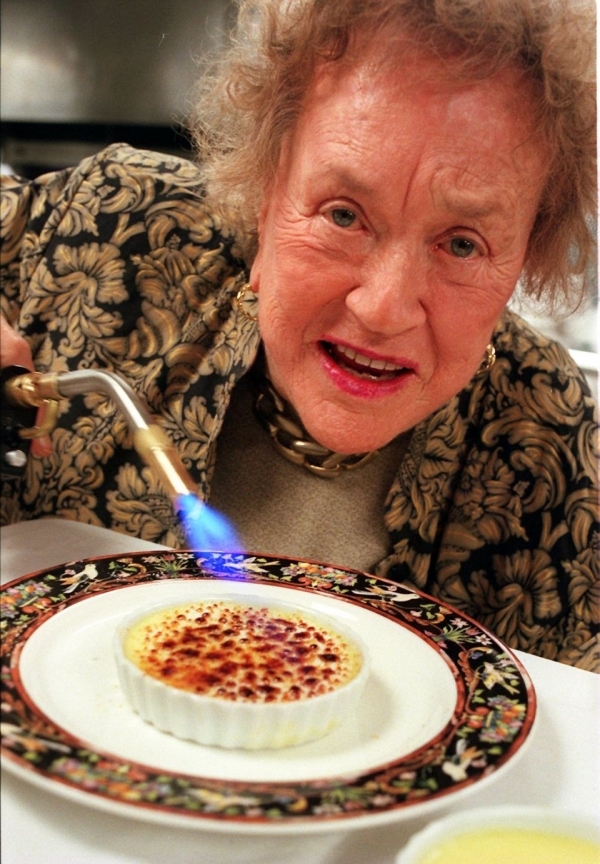Save The Liver!
I just read Bob Spitz's Dearie, a 500+ page biography of Julia Child. Most biographies have an opening section describing the subject's struggles on the way to fame or significance, but Child's life doesn't quite work that way. She didn't even become interested in serious cooking until she was well into her 30s, and didn't become the celebrity we know her as until she was 50.
Born Julia McWilliams, 1912 in Pasadena, she came from money and so never really had to worry about finances. She graduated from Smith College and moved to New York to be a writer. She proved to be a hard and efficient worker when she had jobs, but wasn't sure what to do with her life.
To her family, that answer was simple--her future was to be as a wife and mother. A social butterfly, she was a lively, loud, large woman who put off some men but did not lack for suitors, including those her conservative father approved of. But Julia was looking for something else, and during WWII joined the OSS where she did spy work (generally clerical). She was posted in D.C. and later in Ceylon and China. She met a fellow employee, Paul Child, who was also a self-styled painter, photographer, poet and philosopher. They fell in love and married in 1946, and he helped shape her into what she'd become more than anyone.
He worked with the foreign service of the State Department and got a plum posting in Paris in the late 40s. It was there he introduced Julia to haute cuisine. She'd always enjoyed eating, but this was a whole new world. She decided to become a chef and took courses at Le Cordon Bleu. With hard work and a talent for analysis, she soon became quite adept.
She became acquainted with two Parisians, Simone Beck and Louisette Bertholle, who were writing a cookbook for Americans. They needed someone who could cook, but could also translate what they were doing into language that Americans could appreciate. Julia agreed to join them, little knowing it was the start of a ten-year journey. The book would have hundreds of recipes, each one requiring serious experimentation to get right.
Over the next few years, Paul was assigned to Marseille and then Germany and Norway, but Julia and Simone kept at it (Louisette wasn't pulling her weight and dropped out of the project, though she received credit and royalties). By the time the book was done the Childs (I want to write "Children") were living in Cambridge, Massachusetts. Along the way, Julia and Louisette had trouble finding the proper publisher. No one was sure this cookbook--a serious look at French cuisine in an era of processed food--would sell. After a lot of behind-the-scenes intrigue, Knopf finally put out Mastering The Art Of French Cooking in 1961. The book was well-reviewed and is still considered a classic. It also helped start a new wave in America of taking food seriously.
More important for Julia Child, it helped get her on TV. She started a small show for public television called The French Chef (though some critics noted she was neither French nor a chef). Her bubbly personality and odd voice were riveting, and she became nationally known as stations across the country picked up her show.
She did several seasons of The French Chef--eventually breaking out into color, very helpful for cooking--and then tried other formats, generally working for PBS. She also took a job on Good Morning America where she was seen by an even bigger audience, and made some real money, as PBS was barely a break-even proposition. She also wrote several more cookbooks, including a second volume of Mastering The Art Of French Cooking, all of which sold well now that Julia was the biggest star in the culinary universe. She was so big she became ripe for parody, most famously Dan Aykroyd's Julia Child, who cuts her finger and bleeds to death. Julia loved the bit and would sometimes act it out, shouting "Save the liver!" and laughing.
Through her years of fame she tried to keep current as new chefs and new fashions arose. She also got into arguments with nutritionists, whom she thought were scaring the public away from such delights as butter, cream, alcohol and meat.
No matter what she did, she never coasted. Her shows required intensive rehearsal and her books painstaking research. (In fact, she was scheduled to be on one of the planes from Boston to Los Angeles on 9/11, but postponed the flight because she had to tape something that day.)
Her husband had been a tremendous help, managing her career in its early years. A decade her senior, he had a stroke and lived in failing health during his final years, though Julia did the best she could to keep him involved in her life. He died in 1994 and Julia kept on working. She died in 2004, but here we are, ten years on, and she's still the most famous chef, "French" or otherwise, in the world.
I've never read anything else about Child, but it's hard to imagine there's a better biography out there.




0 Comments:
Post a Comment
<< Home